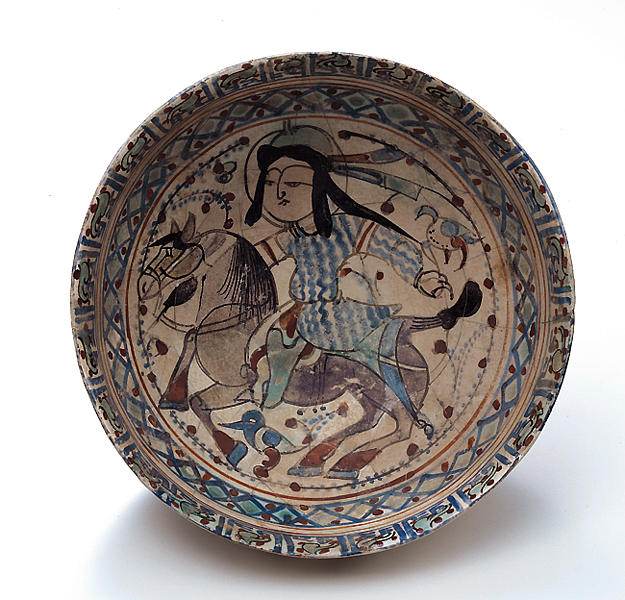色絵騎馬人物図鉢
- イラン
- セルジューク朝時代
- 13c
- 複合陶土
- H-10 D-21
イスラムの胎土は黄緑色か赤褐色だった為、中国の白磁のような白色を作るのに腐心されたが、化粧土や錫釉に加え、新たに石英を混ぜた複合陶土によってそれが可能となった。木灰のようなアルカリ性の溶媒剤を釉薬に混ぜることで焼成中も釉薬が流れる恐れがなくなり、直接器面に絵付けが出来、その上に透明釉をかけて焼き、顔料で上絵付けをして更に低火度で焼き上げる。この手間と経費を惜しまない豪華な色絵陶器は上層階級に愛好された。この作品の人物は被りものからリボンをなびかせ、馬に鞭を当てるようなしぐさをしており、腕付近に鳥が描かれている。輪郭をはっきり書いているため立体感に乏しく、装飾性を強く感じる。
Catalogue Entry
The fritware introduced during the Seljuq period made it possible to create a milk-white appearance in the body of ceramics. Since the clay of Persian pottery is mainly yellowish green and reddish brown, the attainment of this white body required a great deal of ingenious experimentation, but the new development made it possible to use a full palette of colors to carry the painting to its highest expression. Two important examples of Persian ceramic types are lusterware, which requires a second firing, and overglaze painted, which, with its many colors, also requires extra firing--both were produced with seemingly no limitation on the expense and additional labor involved. Both were much in favor with the wealthy upper class.
These also made it possible to apply underglaze painting with cobalt before applying the glaze. An alkali element such as wood ash solvent was mixed into the glaze to stabilize it so that it would not drip down during firing, making it possible to paint directly upon the vessel. After painting, transparent glaze was applied and fired, and then came overglaze painting with colors such as red, black, and dark brown, following which the piece was fired again at a low temperature. This underglaze painting technique thrived from about A.D. 1200. Before long, it crossed over to China, where it developed into what is known as blue-and-white china.
After so many colors became available, the use of arabesques and floral designs exclusively became popular. Many pieces, however, illustrate people engaged in scenes of traditional court life such as audiences, musical performances, drinking parties, poetry readings, and hunts. Many resemble the manuscript paintings of that period, few of which are extant, but instances of similarity in style are numerous. Falconry was a popular pastime of the nobility, as it still is today from the neighboring Arab sheikhdoms to Central Asia. The figure in this bowl has a ribbon fluttering from his headgear--an age-old Persian symbol of royalty, along with the golden halo. He is posed as though urging on the horse, or he might be releasing the bird pictured near his outstretched left hand.
The horseman is drawn to fill in the limited circular confines of the bowl completely. No shading is used, and the drawing is characterized by strong distinct outlines that emphasize the decorative effect but leave the composition lacking in three-dimensionality. The posture of the horse is clumsy, and the movement indicated by its prancing forelegs does not come across well. A plant with red flowers or berries, often seen in mina'i ware, surrounds the horseman around the curve at the base of the rim; in some places, branches are split to fill empty areas. A decorative band of plaid pattern and one of pseudo-calligraphy encircle the bowl near the rim.
TS
